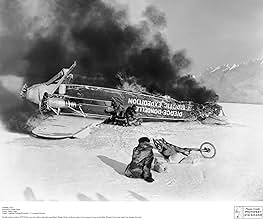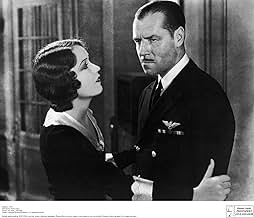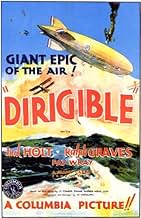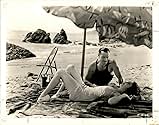Añade un argumento en tu idiomaJack Bradon is tasked to reach the South Pole with a dirigible.Jack Bradon is tasked to reach the South Pole with a dirigible.Jack Bradon is tasked to reach the South Pole with a dirigible.
- Premios
- 2 premios en total
Emmett Corrigan
- Rear Adm. John S. Martin
- (as Emmet Corrigan)
Richard Alexander
- Radio Operator
- (sin acreditar)
Bess Flowers
- Party Guest
- (sin acreditar)
George 'Gabby' Hayes
- Parade Official
- (sin acreditar)
Edward Hearn
- Admiral's Aide
- (sin acreditar)
Selmer Jackson
- Lt. Rowland
- (sin acreditar)
Eddie Kane
- Lakehurst Radio Announcer
- (sin acreditar)
Kenneth MacDonald
- Lt. Fogarty
- (sin acreditar)
Adrian Morris
- Dirigible 'Los Angeles' Crewman
- (sin acreditar)
William H. O'Brien
- Sailor
- (sin acreditar)
Broderick O'Farrell
- Doctor
- (sin acreditar)
Reseñas destacadas
This is a must-see film for people like me. I am a history teacher and love aviation and especially dirigibles. Despite how amazingly large and spectacular these airships were, very few films were ever made about them. Here, fortunately, is a homage to America's rather ill-fated dirigible service operated by the US Navy. Additionally, fans of naval aviation will also be thrilled by the airplanes and aircraft carrier (USS Lexington) featured in the film. However, to those out there that could care less about these things, there is little that will interest you about the film--particularly since the romance in the film seems "tacked on" and confusing.
But first, a bit of background. In the 1930s, the Navy purchased some of these airships from the Germans and also made some their own--all of which eventually crashed! Some of this was due to pilot error and some of this was due to the weaknesses of the American designs. So, since the use of these enormous gas-bags was limited to a very short period of time, there just isn't all that much information about them. In hindsight, they were a very cool idea that was already impractical and outdated--at least as far as military use goes. One of the airships in the film (the Pensacola) did not exist, while the Los Angeles was an actual airship.
So back to the film. The aerial sequences are generally quite good and a lot of actual footage was rather seamlessly integrated into the film--in particular, the amazing Aviation Day sequence where two dirigibles and many non-rigid airships fill the screen. Also, while a bit ponderous, the Antarctic scenes were well made and interesting. BUT, the gratuitous romance just got in the way of the film and made no sense. Because Fay Wray loved her husband so much, she wanted to leave him? And then, when he's nearly killed, she calls off her plans to run away with his ex-best friend and returns! It's convoluted and senseless and a major distraction.
But first, a bit of background. In the 1930s, the Navy purchased some of these airships from the Germans and also made some their own--all of which eventually crashed! Some of this was due to pilot error and some of this was due to the weaknesses of the American designs. So, since the use of these enormous gas-bags was limited to a very short period of time, there just isn't all that much information about them. In hindsight, they were a very cool idea that was already impractical and outdated--at least as far as military use goes. One of the airships in the film (the Pensacola) did not exist, while the Los Angeles was an actual airship.
So back to the film. The aerial sequences are generally quite good and a lot of actual footage was rather seamlessly integrated into the film--in particular, the amazing Aviation Day sequence where two dirigibles and many non-rigid airships fill the screen. Also, while a bit ponderous, the Antarctic scenes were well made and interesting. BUT, the gratuitous romance just got in the way of the film and made no sense. Because Fay Wray loved her husband so much, she wanted to leave him? And then, when he's nearly killed, she calls off her plans to run away with his ex-best friend and returns! It's convoluted and senseless and a major distraction.
Return to the heady days of the 1920s, when the strategic bombers of World War I were still seen as a viable alternative to the rickety airplanes of the day. While the acting is wooden and stereotypical (brave fly boy, conservative large "ship" commander, frail stay at home wife), just seeing the footage of the long-gone rigid airships is worth the tariff.
The best shot is near the beginning, when the camera pans upward, past round naval observation balloons, surprisingly modern non-rigid 'blimps' flying in formation, and then (above them all) the massive (larger by a factor of five or more) dirigible of the title.
Scenes of the real dirigible flying, landing, dropping naval "parachute men", and hooking up to the mooring mast are also worth the time.
Not so much the rest of the movie. Period special effects do not hold up well under modern scrutiny, and the silly pining away of Fay Wray really gets in the way.
(Odd too is the fact that the Review Board passed on a plot line involving an obviously cheating on her husband woman, including a racy scene at the beach where the two have been sharing an afternoon swimming, barely clad by 1930s standards). Perhaps this was during the Hays to Breen transition period, and it slipped under the radar.)
Note that the poor USS Pensacola (a mythical Navy airship; there was a cruiser by that name but never an aircraft) doesn't catch fire, despite the dramatic breakup of the structure. US airship were filled with helium (due to the almost monopolistic corner of the world's supply of helium by the US), and although they suffered through a series of dramatic crashes (Shenandoah, Akron, Macon), none of them caught fire a la the Hindenburg.
Buy it in the newly released DVD for the flying, and try to ignore the rest. (Oh, and Fay Wray looks far better as a brunette than she ever did as a blonde.)
The best shot is near the beginning, when the camera pans upward, past round naval observation balloons, surprisingly modern non-rigid 'blimps' flying in formation, and then (above them all) the massive (larger by a factor of five or more) dirigible of the title.
Scenes of the real dirigible flying, landing, dropping naval "parachute men", and hooking up to the mooring mast are also worth the time.
Not so much the rest of the movie. Period special effects do not hold up well under modern scrutiny, and the silly pining away of Fay Wray really gets in the way.
(Odd too is the fact that the Review Board passed on a plot line involving an obviously cheating on her husband woman, including a racy scene at the beach where the two have been sharing an afternoon swimming, barely clad by 1930s standards). Perhaps this was during the Hays to Breen transition period, and it slipped under the radar.)
Note that the poor USS Pensacola (a mythical Navy airship; there was a cruiser by that name but never an aircraft) doesn't catch fire, despite the dramatic breakup of the structure. US airship were filled with helium (due to the almost monopolistic corner of the world's supply of helium by the US), and although they suffered through a series of dramatic crashes (Shenandoah, Akron, Macon), none of them caught fire a la the Hindenburg.
Buy it in the newly released DVD for the flying, and try to ignore the rest. (Oh, and Fay Wray looks far better as a brunette than she ever did as a blonde.)
Lakehurst, the setting for much of this film was the epicenter of American ballooning and dirigibles, before the second world war and through it as well. A recent book, _They sailed the skies : U.S. Navy balloons and the airship program_ led me to this film, since it represents an easy way to get a look at some of the men and machines in action. Frank "Spig" Wead is the writer and Frank Capra directs. Wead of course was a flyer himself and only turned to writing after a crash broke his neck, crippling him. See WINGS OF EAGLES by John Ford for a dramatization of his life. The early sound era is not known for the sleekness of it's screen story-telling, but if you have interest in the history of zeppelins, or pre-WW2 aviaton, this film is worth watching.
As we watch the Twentieth Century disappear in our wake, we're going to find films like this more and more precious. I mean, can you imagine? -- Here's a film that takes the airship absolutely seriously as an equal partner with the airplane. Here's a film that shows you basically how an airship was constructed and what it looked like inside, and all that as part of the plot! And if you're going to interrupt the main plot with a soap opera, who better to put in front of your eyes than the beautiful Fay Wray? And what a great way to get out of the romantic sub-plot's basic dilemma -- nice, clean, and fast. All things considered, a more than satisfying way to spend an evening.
A reasonably decent motion picture for its time, the one attribute that makes this film stand out from its standard storyline, is its footage and scenes regarding dirigibles. When this film was released in 1931, it was the golden age of zeppelin travel, and the crash of the Hindenburg, which doomed this type of transportation, was still five years in the future. There were numerous scenes shot at Lakehurst Naval Air station, where ironically the Hindenburg crashed, that was the center of dirigible activity at the time for the U.S. Navy. As someone who is interested in this subject, I found this part of the movie fascinating as well as the part of the story that took you behind the scenes of airship travel and how much danger could be involved. The riveting scene dealing with the crash of a dirigible in a violent storm brought to mind the U.S. Navy zeppelin Akron, launched the same year as this film, which was destroyed in a similar storm only two years later. It was also interesting to see actress Fay Wray two years before she would gain fame with her role in King Kong. I had the opportunity to catch this film recently during an airing on the TCM cable channel and would recommend it for anyone with a similar interest.
¿Sabías que...?
- CuriosidadesThe production was shot during a California heat wave. To form vapor on the breath and give the impression that the pilots were in the Antarctic, the performers were given lumps of 'dry ice' (frozen carbon dioxide) in metal boxes to put in their mouths. Hobart Bosworth found the box cumbersome and simply put the ice in his mouth. He lost his tongue and most of his lower jaw.
- PifiasThe name of this Dirigible was the USS Pensacola but there was already a USN heavy cruiser of the same name that was in service since 1928 when this movie was made. The Navy does not assign duplicate names to ships/air ships in service at the same time.
- ConexionesFeatured in Frank Capra's American Dream (1997)
- Banda sonoraAnchors Aweigh
(1906) (uncredited)
Music by Charles A. Zimmerman
Lyrics by Alfred Hart Miles and R. Lovell
Played during the opening credits and often in the score
Sung by guests at a party
Selecciones populares
Inicia sesión para calificar y añadir a tu lista para recibir recomendaciones personalizadas
Detalles
- Fecha de lanzamiento
- País de origen
- Idioma
- Títulos en diferentes países
- Dirižabl
- Localizaciones del rodaje
- San Gabriel Valley, California, Estados Unidos(South Pole scenes)
- Empresa productora
- Ver más compañías en los créditos en IMDbPro
Taquilla
- Presupuesto
- 1.000.000 US$ (estimación)
- Duración1 hora 40 minutos
- Color
Contribuir a esta página
Sugerir un cambio o añadir el contenido que falta






































